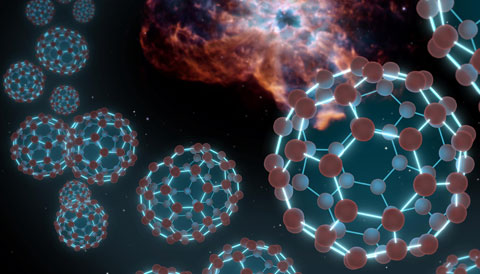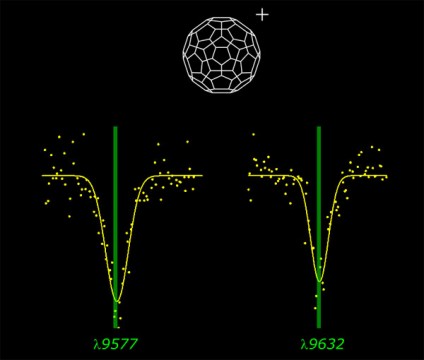Soccer-ball-shaped molecules lurking in the dusty corners of the Milky Way help resolve a long-standing conundrum.
The term “diffuse interstellar bands” may not run chills down your back, but it’s code for a spectral mystery that has haunted astronomers for almost a century. First discovered in 1922, these absorption lines (more than 400 of them) are seen anytime astronomers look toward dust-reddened stars. But no ions or molecules tested in the lab have provided a good match. Sometimes the bands even appear where there’s very little dust.

NASA / JPL-Caltech
Now new research published in the July 16 Nature has finally confirmed that buckyballs — officially known as buckminsterfullerene, a molecule that links 60 carbon atoms into a soccer-ball-shaped cage — are responsible for two of these mysterious absorption bands.
Buckyballs lie on the periphery of our ordinary experience, showing up in small amounts among soot particles and easily created in the lab. (In fact, some chemists are building so-called buckybombs, nanoscale explosives designed to attack cancer cells.) The molecule’s extremely stable lattice shape withstands high temperatures and pressures.
Given its stability, it’s not surprising that this molecule might exist in space. The Spitzer Space Telescope had detected buckyballs several years ago: in their gaseous form in 2010, and in their solid form, where the spheres stack together like oranges in a crate, in 2012. But knowing that these molecules could exist in space was only the first step.

E. K. Campbell / Nature
Neutral buckyballs don’t absorb light at the right wavelengths to explain diffuse interstellar bands, but ionized buckyballs could. So Ewen Campbell (University of Basel, Switzerland) and colleagues trapped a few thousand charged buckyballs, then cooled them to the icy temperature of the interstellar medium by colliding them with cold (5.8 K or -449°F) helium atoms. Then the chemists measured the spectrum.
What they found was an exact match to two diffuse interstellar bands, a confirmation that at least two of these mysterious absorption bands are due to the presence of charged buckyballs in space.
The loss of an electron reshapes the buckyball slightly, by the way, so it's no longer quite the shape of a soccer ball. They're "slightly distorted, not that anybody but a spectroscopist would notice," says co-author John Maier (University of Basel, Switzerland). "A bit like when Messi kicks a football — it becomes a bit squashed."
Buckyballs aren’t the only carbon-bearing molecule lurking in interstellar space either. It’s likely that a number of other molecules, such as polycyclic aromatic hydrocarbons (smelly molecules also found in fossil fuels, natural crude oil, and coal deposits) or silicon-tipped carbon chains, are responsible for the remaining absorption bands. But these other suggestions still await confirmation.
So that’s two down, 400 or so to go . . .

P. Jenniskens & F.-X. Desert
 1
1
Comments
Joe Slomka
July 24, 2015 at 4:39 pm
Monica,
PBS had an interesting NOVA episode about buckyballs.
An obscure Texas astronomer was determined to find out what caused those spectra.
Teamed with the Max Planck Institute, he and fellow Texas chemical scientists determined it
was buckyballs. The episode is no longer available on the PBS website, but I have a copy of it
on VHS tape. This episode aired about 15 years ago.
You must be logged in to post a comment.
You must be logged in to post a comment.